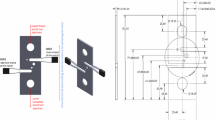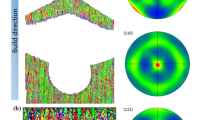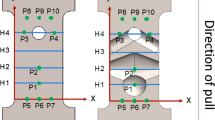Abstract
The prediction of crack initiation, propagation, and ductile fracture in a large scale metallic structure has posed a great challenge to the design and certification community. The complexity in component geometry, material heterogeneity, and the 3D stress distribution, will likely make the crack growth curvilinear. An accurate 3D stress prediction is essential to predict the ductile fracture that is controlled by void nucleation, growth and coalescence. To alleviate the computational burden associated with the use of a 3D solid finite element modeling coupled with a remeshing of the ductile failure prediction of a large scale structure, a novel approach based on the coupling of an extended finite element for shell elements and a plane strain core characterization of a cracked region is developed to efficiently simulate an arbitrary crack growth in a large scale thin-walled structure and its associated load deflection curve while retaining a sufficient level of computational efficiency. The methodology is implemented in Abaqus’ explicit solver via its VUEL where a kinematic description of a cracked shell is accomplished via the use of phantom-paired elements. A plane strain core that controls the mixture of plane stress and plane strain components is introduced for a rational representation of localized plasticity induced 3D stress state for the prediction of a ductile failure initiation. A cohesive injection is applied on the newly created crack surface to dissipate the energy during the crack propagation. The resulting XSHELL toolkit for Abaqus is applied for the ductile failure prediction of the 2012 Sandia fracture challenge problem. A blind prediction is performed first using geometry independent plane strain core parameters followed by a refined analysis based on a set of well-calibrated material and plane strain core parameters from Sandia’s tensile and compact testing data.






























Similar content being viewed by others
References
Areias PMA, Song JH, Belytschko T (2005) A finite-strain quadrilateral shell element based on discrete Kirchhoff-Love constraints. Int J Numer Meth Eng 64:1166–1206
Boyce BL, Kramer SLB, Fang HE, et al (2013) The Sandia fracture challenge: blind round robin predictions of ductile tearing. Int J Fract (submitted)
Brunig M, Chyra O, Albrecht D, Driemeier L, Alves M (2008) A ductile damage criterion at various stress triaxialities. Int J Plast 24:1731–1755
Bai Y, Wierzbicki T (2008) A new model of metal plasticity and fracture with pressure and Lode dependence. Int J Plast 24:1071–1096
Belytschko T, Lin JI (1984) Explicit algorithms for the nonlinear dynamics of shells. Comput Methods Appl Mech Eng 42(2):225–251
Charles E, Harris CE, Newman JC, Piascik RS, Starnes JH (1998) Analytical methodology for predicting widespread fatigue damage onset in fuselage structure. J Aircr 35(2):307–317
Clausen AH, Børvik T, Hopperstad OS, Benallal A (2004) Flow and fracture characteristics of aluminium alloy AA5083-H116 as function of strain rate, temperature and triaxiality. Mater Sci Eng A 364:260–272
Camacho GT, Ortiz M (1996) Computational modelling of impact damage in brittle materials. Int J Solids Struct 33:2899–2938
Dodds RH, Read DT (1985) Experimental and analytical estimates of the J-integral for tensile panels containing short center cracks. Int J Fract 28(1985):39–54
Gurson AL (1977) Continuum of ductile rupture by void nucleation and growth: part I. Yield criteria and flow rules for porous ductile media. J Eng Mater Technol 99:2–55
Gao X, Zhang T, Zhou J, Graham SM, Hayden M, Roe C (2011) On stress-state dependent plasticity modeling: significance of the Hydrostatic stress, the third invariant of stress deviator and the non-associated flow rule. Int J Plast 27:217–231
Gao X, Zhang T, Hayden M, Roe C (2009) Effects of the stress state on plasticity and ductile failure of an aluminum 5083 alloy. Int J Plast 25(12):2366–2382
Hansbo A, Hansbo P (2004) A finite element method for the simulation of strong and weak discontinuities in solid mechanics. Comput Methods Appl Mech Eng 2004(193):3523–3540
Huespe AE, Needleman A, Oliver J, Sáncheza PJ (2009) A finite thickness band method for ductile fracture analysis. Int J Plast 25(12):2349–2365
Hughes TJR, Liu WK (1981a) Nonlinear finite element analysis of shells: part I. Three-dimensional shells. Comput Methods Appl Mech Eng 26:331–362
Hughes TJR, Liu WK (1981b) Nonlinear finite element analysis of shells: part II. Two-dimensional shells. Comput Methods Appl Mech Eng 27:167–181
Hu W, Liu H (1976) Crack tip dtrain—a comparison of finite element method calculations and Moiré measurements. Cracks and fracture, ASTM STP 601. Am Soc Test Mater 1976:522–534
Johnson GR, Cook WH (1985) Fracture characteristics of three metals subjected to various strains, strain rates, temperatures and pressures. Eng Fract Mech 21:31–48
Lua J, Liu L, Chessa J, Peng S (2012) Crack growth and residual strength prediction of thin-walled aluminum structures using XSHELL, 53rd AIAA/ASME/ASCE/AHS/ASC Structures, structural dynamics and materials conference, 23–26 April 2012, Honolulu, Hawaii, AIAA 2012-1697
Larsson R, Mediavilla J, Fagerström M (2011) Dynamic fracture modeling in shell structures based on XFEM. Int J Numer Meth Eng 86:499–527
McClintock FA (1968) A criterion for ductile fracture by the growth of holes. J Appl Mech 35(2):363–371
Murthy SS, Gallagher RH (1986) A triangular thin-shell finite element based on discrete Kirchhoff theory. Comput Methods Appl Mech Eng 54:197–222
Mostofizadeh S, Fagerström M, Larsson R (2013) Dynamic crack propagation in elastoplastic thin-walled structures: Modelling and validation. Int J Numer Methods Eng (2013). doi:10.1002/nme.4524
Mahmoud S, Lease K (2004) Two-dimensional and three-dimensional finite element analysis of critical crack-tip-opening angle in 2024-T351 aluminum alloy at four thicknesses. Eng Fract Mech 71(2004):1379–1391
Nahshon K, Hutchinson JW (2008) Modification of the Gurson Model for shear failure. Eur J Mech A Solids 27(1):1–17
Oyane M (1972) Criteria of ductile fracture strain. Bull JSME 15(90):1507–1513
Rice JR, Tracey DM (1969) On the ductile enlargement of voids in triaxial stress fields. J Mech Phys Solids 17(3):201–217
Song JH, Areias PMA (2006) A method for dynamic crack and shear band propagation with phantom nodes. Int J Numer Meth Eng 2006(67):868–893
Song JH, Belytschko T (2009) Dynamic fracture of shells subjected to impulsive loads. J Appl Mech 76(5):051301
Simo J C, Hughes TJR (2000) Computational inelasticity. Interdisciplinary Applied Mathematics, vol 7. Springer, Berlin
Sun X, Choi KS, Liu WN, Khaleel MA (2009) Predicting failure modes and ductility of dual phase steels using plastic strain localization. Int J Plast 25:1888–1909
Tvergaard V, Needleman A (1984) Analysis of the cup-cone fracture in a round tensile bar. Acta Metall 32(1):157–169
Woelke PB, Abboud N (2012) Modeling fracture in large scale shell structures. J Mech Phys Solids 60(2012):2044–2063
Xu XP, Needleman A (1994) Numerical simulations of fast crack growth in brittle solids. J Mech Phys Solids 42:1397–1434
Xue L (2009) Stress based fracture envelope for damage plastic solids. Eng Fract Mech 76:419–438
Xue L, Wierzbicki T (2009) Numerical simulation of fracture mode transition in ductile plates. Int J Solids Struct 46(2009):1423–1435
Zerbst U, Heinimann M, Donne CD, Steglich D (2009) Fracture and damage mechanics modelling of thin-walled structures—an overview. Eng Fract Mech 76:5–43
Acknowledgments
The authors are grateful for the support provided by the Office of naval Research (N00014-11-C-0487) for which Dr. Paul Hess and Dr. Ken Nahshon serve as the technical monitors. We also extend our thanks to Prof. Robert Dodds for his helpful suggestions
Author information
Authors and Affiliations
Corresponding author
Rights and permissions
About this article
Cite this article
Zhang, T., Fang, E., Liu, P. et al. Modeling and simulation of 2012 Sandia fracture challenge problem: phantom paired shell for Abaqus and plane strain core approach. Int J Fract 186, 117–139 (2014). https://doi.org/10.1007/s10704-013-9917-1
Received:
Accepted:
Published:
Issue Date:
DOI: https://doi.org/10.1007/s10704-013-9917-1




